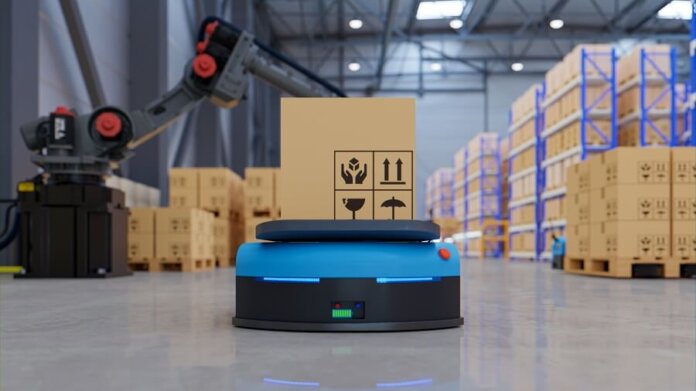Warehouse robotics pertains to automated systems, specialized software robots used in the warehouse industrial process to carry materials and execute various jobs.
Currently, robotics has achieved prominence in the distribution system, supply chain, and warehouse management. As per ABI Research, by 2025, about 4 million robots produced by a warehouse robotics company will be placed in over 50,000 warehouses.
Warehouses are focusing on the usage of robotics in response to technology improvements and an increasingly competitive market landscape. They can boost accuracy, productivity, and operational efficiency.
Warehouse operations benefit greatly from the deployment of robots. They aid in the reduction and elimination of errors and the expediting of order fulfillment.
- AGVs (automated guided vehicles) aid in transporting materials, commodities, and supplies within warehouse facilities. AGVs are utilized to replace manually powered pick carts or forklifts in operations.
- Automated storage and retrieval systems are computer-controlled systems that aid in inventory management and the storage of items on demand. These devices are intended to make product retrieval and placement more efficient.
- Collaborative robots are mobile semi-autonomous robots. These are intended to assist human warehouse workers in doing various activities. Some robots also accompany human pickers around the warehouse, acting as mobile storage containers for picked orders. These are equipped with sensors to differentiate between barriers and boxes. They can also aid in order fulfillment by transporting picked orders to personnel in other warehouse areas, such as packing or sorting stations.
- Articulated robotic arms (ARA) are multi-jointed appendages used to manage objects within distribution centers and warehouses. Because these arms can move, pivot, and lift, they can be used for packing, receiving, and storing, among other things.
- G2P technology is similar to the AS/RS system. G2P is a storage system that delivers things to static pick terminals where human workers complete requests. In contrast, G2P systems provide the greatest potential for return on investment.
Warehouse robotics technology advancement
Robotics play an important role in warehouses, addressing basic supply chain management concerns such as enhancing order fulfillment and inventory management while keeping ahead of the competitors.
They necessitate considerable infrastructure upgrades, which contribute to large capital costs and implementation downtime.
Warehouse robotics reduces the time and resources required for obtaining and transferring things throughout the warehouse floor, freeing up human workers to focus on more complex activities such as packaging and shipping orders.
- Warehouse robotics increases inventory management productivity and accuracy. Human errors can be minimized. Warehouse robots automate product handling, picking, sorting, and resupply.
- Picking is a typical practice in warehouse operations. Moving merchandise around to carry out order items or place goods in storage bins is a key aspect of order fulfillment and restocking. By lowering travel time through the warehouse, order picking machines minimize order processing times and related costs.
- Although sorting is simple for humans, it is a difficult task to automate. Conveyors, sensors, cameras, arms, and algorithms are commonly used in the warehouse sorting robots to correctly identify things and transport them to the appropriate storage place.
- Warehouse robotics also include an automated system for packaging machines, which aids in speeding up packing activities.
- Robotic transportation systems, such as conveyor systems, monorails, and AGVs, assist in moving pallets and items from one area to another, easing the burden on humans.
- The lessening of mental and physical strain on human workers’ risky components of warehouse operations. Reduced burden on employees enhances their mood, boosting productivity and producing a positive working environment.
- By employing the correct robots, warehouses may improve operational efficiency, reduce mistake rates, and conduct order fulfillment procedures with greater accuracy, so that human workers can devote their time and attention to complex tasks requiring critical thinking or fine motor skills.
Using robots manufactured by a warehouse robotics company has enormous potential and will be critical to the progress of modern warehouse management.
Moving things from one location to the other with very little human connection contributes to supply chains that can fulfill orders quickly and seamlessly.
Investing in this equipment and smart technology will allow businesses to continue to satisfy rising client demands.

